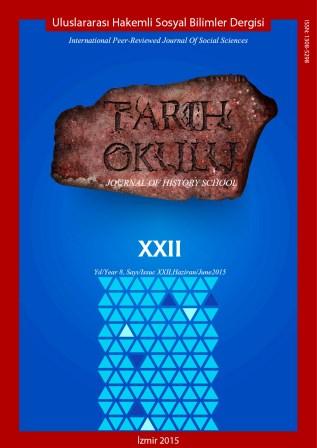Author :
Abstract
Eskiçağ’da Yakındoğu’da toplumların kendi inanç ve kültürleri çerçevesinde bazı sembolleri kullandıkları ve bunlara ortak anlamlar yükledikleri anlaşılmaktadır. Nar sembolü de söz konusu toplumların arkeolojik kaynakları başta olmak üzere, mitolojik ve yazılı kaynaklarına yansımış önemli bir sembol olarak karşımıza çıkmaktadır. Hatta Semavi din kitaplarının verdiği bilgiler de harmanlandığı zaman, söz konusu tüm kaynakların aslında aynı şeyi söylemeye çalıştıklarını görüyoruz: Nar yani bereket, dişilik, verimlilik, kutsallık ve belki de yasak olan meyve!“Yasak meyve”nin cinsi, Semavi din kitaplarında açık olarak belirtilmediği için bu hususta farklı görüşler ortaya atılmıştır. Nar da adı geçen meyvelerden birisidir. Bu çalışmada söz konusu meyvenin, Eski Yakındoğu toplumlarında sembolik anlamda taşıdığı değer ve farklı ideolojilerde algılanış biçimi üzerinde durulmuştur.
Keywords
Abstract
The Near East civilizations used various symbols and gave them the same meaning in the Ancient Times. We understand that the pomegranate was one of the important symbols which seemed on the archaeological sources, mythological stories and the written records of the Ancient Near East civilizations. In addition, The Holy Books have the pomegranate as an holy fruit. When the all kind of sources were collected we can see that all of them say the same things regarding pomegranate: fertility, sexuality, holiness and also (maybe) the “forbidden fruit”!What the “forbidden fruit” is in The Holy Books is not clear. Because of that many opinions came up regarding the “forbidden fruit”. One of the opinion is that the “forbidden fruit” can be “pomegranate”. This study discusses how pomegranate was perceived as a symbol in the Ancient Near East and other different ideologies.
Keywords
- Bebek 2005: Adil Bebek, “Cennet Meyveleri Örneğinde Ahiret Hayatına Kelamî Bir Bakış”, Fırat Ü. İlahiyat Fakültesi Dergisi 10: 2, Elazığ 2005, s.1
- Bennett 2011: Matt Bennett, “The Pomegranate: Marker of Cyclical Time, Seeds of Eternity”, İnternational Journal of Humanities and Social Science, Vol.1, No.19, Decemvir 2011, s.52-59.
- Bertman 2003: Stephen Bertman, Handbook to Life in Ancient Mesopotamia, New York 2003.
- Cerrahoğlu 2012: Münir Cerrahoğlu, “Mitolojilerde ve Türkiye’de Derlenen Masallarda Narın Yeri”, Turkish Studies, Vol.7/1 (Winter), 2012,
- Çamdereli 2007: Mete Çamdereli, “Nar’ın Göstergesel İklimi: Bir Ön Çalışma”, Journal of İstanbul Kültür University, 2007/3, İstanbul 2007, s. 63
- Çetin 2006: Cengiz Çetin, “Anadolu’da Bereket Kültü ve Anadolu’da Türk Köylüsü Seyirlik Oyunlarına Yansımaları”, A.Ü.Dil ve Tarih-Coğrafya Fakültesi Dergisi, 46/1, Ankara 2006, s.189-210.
- Çetin 2008: Cengiz Çetin, “Türk Düğün Gelenekleri ve Kutsal Evlilik Ritüeli”, A.Ü.D.T.C.F. Dergisi, 48/ 2, Ankara 2008, s.111-126.
- Çoban 2007: Melih Çoban, “Eskiçağ Toplumlarında Meyve Kültü”, Bilim ve Gelecek, S.39, s.81-85.
- Delikgöz-Alıç 2010: Ömer Delikgöz-Fulya Alıç, “Osmanlı İstanbul’unda Bulunan Bazı Müslim ve Gayrimüslim Mezarlıklarındaki Kimi Semboller”, Hacettepe Üniversitesi, Türkiyat Araştırmaları Dergisi 13 (Güz), Ankara 2010,
- Durand 1998: Gilbert Durand, Sembolik İmgelem, Çev. A.Meral, İnsan Yay., İstanbul 1998.
- Eliade 1992: Mircae Eliade, İmgeler Simgeler, Çev. M.A.Kılıçbay, Gece Yay., Ankara 1992.
- Eliade 2003: Mircae Eliade, Dinler Tarihine Giriş, Çev.L.Arslan, Kabalcı Yay., İstanbul 2003.
- Goor 1967: Asaph Goor, “The History of the Pomegranate in the Holy Land”, Economy Botany, Vol.21, No.3, Jul.-Sep. 1967, s. 215-230.
- http://www.religionfacts.com/christianity/symbols/pomegranate.htm Erişim 15.06.2015 14:30.
- Immerwahr 1989: Sara A. Immerwahr, “The Pomegranate Vase: Its Origins and Continuity”, The Journal of The American School of Classical Studies at Athens, Vol.58, No.4, 1989, s.397-410.
- İsmail 2008: Mehmet İsmail, “Azerbaycan Sözlü ve Yazılı Edebiyatında Nar”, Turkish Studies, Vol.3/5, Fall 2008, s.217-226.
- Jaffar 2002: Tamara Agha- Jaffar, Demeter and Persofone: Lessons from a Myth, McFarland 2002.
- Jannot 2009: Jean-René Jannot, “The Lotus, Poppy and Other Plants in Etruscan Funerary Contexts”, Etruscan by Definition: The Cultural, Regional and Personal Identity of the Etruscans, Papers in honour of Sybille Haynes, MBE, Edited by J.Swaddling-P.Perkins, British Museum Research Publication 173, London 2009, s.81-86.
- Limet 1987: Henri Limet, “The Cuisine of Ancient Sumer”, The Biblical Archaeologist, Vol.50, No.3, Sep.1987, s.132-147.
- Magness 2001: Jodi Magness, “The Cults of Isıs and Kore at Samaria- Sebaste in the Hellenistic and Roman Periods”, The Harvard Theological Review, Vol.94, No.2, April 2001, s. 157-177.
- Mark 2015: Joshua J. Mark, “The Banquet Stele of Ashurnasirpal II”, www.ancient.eu/article/730, Erişim 17.02.2015, 20:25.
- Matthews 2001: Victor Matthews (ed.), Desire, Discord and Death Approaches to Ancient Near Eastern Myth, American Schools of Oriental Research, Boston 2001.
- Özbay 2013: Ender Özbay, “Adem-Havva-Lilith Figürleri İzlendiğinde Bir Olanaksızlık Miti: Aşk”, İdil Dergisi, C.2, S.10, 2013, s.40-58.
- Parpola 1993: Simo Parpola, “The Assyrian Tree of Life: Tracing the Origins of Jewish Monoteism and Greek Philosophy”, JNES, Vol.52, No.3, Jul. 1993, s. 161-208.
- Riddle 2010: John M. Riddle, Goddesses, Elixirs, and Witches: Plants and Sexuality Throught Human History, Palgrave Macmillan, New York 2010.
- Ancient Near East, Vol.1, Eds. H.Kühne-R.Czichan etc., Wiesbaden 2008,
- Spitz 1990: Ellen Handler Spitz, “Mothers and Daughters: Ancient and Modern Myths”, The Journal of Aesthetics and Art Criticism, Vol.48, No.4, Autumn 1990, s.411-420.
- Stover-Mercure 2007: Ed Stover - Eric W. Mercure, “The Pomegranate: A New Look at the Fruit of Paradise”, HortScience, Vol.42 (5), August 2007,
- Ward 2003: Cheryl Ward, “ Pomegranates in Eastern Mediterranean Contexts during the Late Bronze Age”, World Archaeology, Vol 34 (3), 2003,
- Wilkinson 2013: Toby Wilkinson, Eski Mısır, Çev. Ü.H.Yolsal, Say





